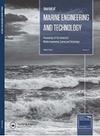ROPAX型船舶双可控螺距螺旋桨最小油耗优化程序
IF 2.6
4区 工程技术
Q1 Engineering
Journal of Marine Engineering and Technology
Pub Date : 2022-08-11
DOI:10.1080/20464177.2022.2106623
引用次数: 8
摘要
将螺旋桨设计工具与非线性优化器相结合,建立了螺旋桨优化程序。优化的螺旋桨有助于海上脱碳和减轻船舶废气排放。该优化过程的主要目标是选择Kaplan 19A系列的两种导管式可控螺距螺旋桨,以服务速度用于在平静水域航行的滚装/滚装客船作为案例研究。选定的船舶由两台四冲程船用柴油发动机操作,每台发动机通过变速箱和螺旋桨轴连接到一个可控螺距螺旋桨。螺旋桨的选择是在发动机工作点以最小的燃油消耗进行的,而不是只考虑最大的螺旋桨效率。考虑到噪声和空化标准的限制,对螺旋桨直径、节距、扩展面积比、转速以及齿轮箱比进行了优化。将各模拟计算结果与船舶设计中采用的螺旋桨效率最大化选择的典型方法进行了比较。结果表明,与只考虑螺旋桨效率相比,从油耗方面对螺旋桨进行优化可以减少5.2%的油耗。本文章由计算机程序翻译,如有差异,请以英文原文为准。
Optimization procedures for a twin controllable pitch propeller of a ROPAX ship at minimum fuel consumption
A propeller optimization procedure is developed by coupling a propeller design tool with a nonlinear optimizer. An optimized propeller contributes toward maritime decarbonization and the mitigation of exhaust emissions from ships. The main objective of this optimization procedure is to select two ducted controllable pitch propellers from the Kaplan 19A series at the service speed for a roll-on/roll-off passenger ship sailing in calm water as a case study. The selected ship is operated by two four-stroke marine diesel engines, each connected to a controllable pitch propeller via a gearbox and a propeller shaft. The propeller selection is performed at the engine operating point with minimum fuel consumption instead of considering only the maximum propeller efficiency. The propeller diameter, pitch, expanded area ratio and rotation speed are optimized as well as the gearbox ratio taking into account the limitations of noise and cavitation criteria. The calculated results from each simulation are compared with the typical procedure used in ship design, which is the selection of the propeller at maximum efficiency. The results show that optimizing the propeller in terms of fuel consumption can reduce the amount of fuel consumed by up to 5.2% rather than only considering the propeller efficiency.
求助全文
通过发布文献求助,成功后即可免费获取论文全文。
去求助
来源期刊

Journal of Marine Engineering and Technology
工程技术-工程:海洋
CiteScore
5.20
自引率
0.00%
发文量
0
审稿时长
>12 weeks
期刊介绍:
The Journal of Marine Engineering and Technology will publish papers concerned with scientific and theoretical research applied to all aspects of marine engineering and technology in addition to issues associated with the application of technology in the marine environment. The areas of interest will include:
• Fuel technology and Combustion
• Power and Propulsion Systems
• Noise and vibration
• Offshore and Underwater Technology
• Computing, IT and communication
• Pumping and Pipeline Engineering
• Safety and Environmental Assessment
• Electrical and Electronic Systems and Machines
• Vessel Manoeuvring and Stabilisation
• Tribology and Power Transmission
• Dynamic modelling, System Simulation and Control
• Heat Transfer, Energy Conversion and Use
• Renewable Energy and Sustainability
• Materials and Corrosion
• Heat Engine Development
• Green Shipping
• Hydrography
• Subsea Operations
• Cargo Handling and Containment
• Pollution Reduction
• Navigation
• Vessel Management
• Decommissioning
• Salvage Procedures
• Legislation
• Ship and floating structure design
• Robotics Salvage Procedures
• Structural Integrity Cargo Handling and Containment
• Marine resource and acquisition
• Risk Analysis Robotics
• Maintenance and Inspection Planning Vessel Management
• Marine security
• Risk Analysis
• Legislation
• Underwater Vehicles
• Plant and Equipment
• Structural Integrity
• Installation and Repair
• Plant and Equipment
• Maintenance and Inspection Planning.
 求助内容:
求助内容: 应助结果提醒方式:
应助结果提醒方式:


